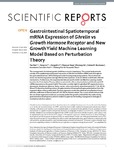Mostrar o rexistro simple do ítem
Gastrointestinal Spatiotemporal mRNA Expression of Ghrelin vs Growth Hormone Receptor and New Growth Yield Machine Learning Model Based on Perturbation Theory
| dc.contributor.author | Ran, Tao | |
| dc.contributor.author | Liu, Yong | |
| dc.contributor.author | Li, Hengzhi | |
| dc.contributor.author | Tang, Shaoxun | |
| dc.contributor.author | He, Zhixiong | |
| dc.contributor.author | Munteanu, Cristian-Robert | |
| dc.contributor.author | González-Díaz, Humberto | |
| dc.contributor.author | Tan, Zhiliang | |
| dc.contributor.author | Zhou, Chuanshe | |
| dc.date.accessioned | 2019-04-10T11:09:47Z | |
| dc.date.available | 2019-04-10T11:09:47Z | |
| dc.date.issued | 2016-07-27 | |
| dc.identifier.citation | Ran T, Liu Y, Li H, et al. Gastrointestinal spatiotemporal mRNA expression of ghrelin vs growth hormone receptor and new growth yield machine learning model based on perturbation theory. Sci Rep. 2016; 6:30174 | es_ES |
| dc.identifier.issn | 2045-2322 | |
| dc.identifier.uri | http://hdl.handle.net/2183/22609 | |
| dc.description.abstract | [Abstract] The management of ruminant growth yield has economic importance. The current work presents a study of the spatiotemporal dynamic expression of Ghrelin and GHR at mRNA levels throughout the gastrointestinal tract (GIT) of kid goats under housing and grazing systems. The experiments show that the feeding system and age affected the expression of either Ghrelin or GHR with different mechanisms. Furthermore, the experimental data are used to build new Machine Learning models based on the Perturbation Theory, which can predict the effects of perturbations of Ghrelin and GHR mRNA expression on the growth yield. The models consider eight longitudinal GIT segments (rumen, abomasum, duodenum, jejunum, ileum, cecum, colon and rectum), seven time points (0, 7, 14, 28, 42, 56 and 70 d) and two feeding systems (Supplemental and Grazing feeding) as perturbations from the expected values of the growth yield. The best regression model was obtained using Random Forest, with the coefficient of determination R2 of 0.781 for the test subset. The current results indicate that the non-linear regression model can accurately predict the growth yield and the key nodes during gastrointestinal development, which is helpful to optimize the feeding management strategies in ruminant production system. | es_ES |
| dc.description.sponsorship | National Natural Science Foundation of China; 31320103917 | es_ES |
| dc.description.sponsorship | State of California; XDA05020700 | es_ES |
| dc.description.sponsorship | National Space Science Center (China); 2010T2S13 | es_ES |
| dc.description.sponsorship | National Space Science Center (China); 2012T1S0009 | es_ES |
| dc.description.sponsorship | Hunan Provincial People's Government (China); 2013TF3006 | es_ES |
| dc.description.sponsorship | Xunta de Galicia; GRC2014/049 | es_ES |
| dc.language.iso | eng | es_ES |
| dc.publisher | Nature | es_ES |
| dc.relation.uri | https://doi.org/10.1038/srep30174 | es_ES |
| dc.rights | Atribución 3.0 España | es_ES |
| dc.rights.uri | http://creativecommons.org/licenses/by/3.0/es/ | * |
| dc.subject | Abomasum | es_ES |
| dc.subject | Animal feed | es_ES |
| dc.subject | Gastrointestinal tract | es_ES |
| dc.subject | Gene expression | es_ES |
| dc.subject | Ghrelin | es_ES |
| dc.subject | Goats | es_ES |
| dc.subject | Machine learning | es_ES |
| dc.subject | RNA messenger | es_ES |
| dc.subject | Receptors | es_ES |
| dc.subject | Rumen | es_ES |
| dc.title | Gastrointestinal Spatiotemporal mRNA Expression of Ghrelin vs Growth Hormone Receptor and New Growth Yield Machine Learning Model Based on Perturbation Theory | es_ES |
| dc.type | info:eu-repo/semantics/article | es_ES |
| dc.rights.access | info:eu-repo/semantics/openAccess | es_ES |
| UDC.journalTitle | Scientific Reports | es_ES |
| UDC.volume | 6 | es_ES |
| UDC.startPage | 30174 | es_ES |
Ficheiros no ítem
Este ítem aparece na(s) seguinte(s) colección(s)
-
GI-RNASA - Artigos [177]






